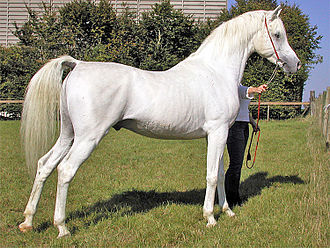The Bedouin nomadic tribes are well-known all over the world for breeding pure Arabians. Luckily, the culture of the Bedouin tribe was rich in oral practice, so the breeding history of Arabian horses has been preserved up until this day.
Image attributed to Wikimedia Heather Moreton
Many websites have fine-quality of Arabian horses for sale at all times
Arabian horses are amazingly versatile. They are easily recognised because of their striking features. If you are planning to buy an Arabian horse, the Internet is a great place to look for Arabian horses for sale. However, before making a final decision you should learn about the various strains of Arabians so that you can make a sensible choice.
At one time, there were numerous strains of Arabians, but now most of them are extinct. Here are five particular strains (types and families) of Arabian horses that you can find today.
- The Kuhaylan, or Kohelian
The name of the strain “Kohelian” is derived from the word “kohl.” Arabians that belong to the Kuhaylan family have distinctive black skin around their eyes. This makes it look like their eyes are lined with kohl, a substance used by women to darken their eyelids. Kuhaylan horses are considered the original Arabians, as the rest of the strains are derived from this one. Distinguished features of Kohelian Arabians include strength, muscularity, symmetry, and balance. Their foreheads are generally flat, and they are broad across the back, gaskin, chest, and croup. Kohelian Arabians tend to be of a quieter nature than other horses.
- The Hamdani
Hamdani Arabians are slightly taller than Kuhaylan horses and of a longer frame, with more protruding withers coming out of their back. They are masculine and have a very strong hind. The Hamdani are known for their great stamina and endurance. You will usually find them in grey, but there are also very few that are white.
- The Abayyan
Although more refined and spirited than Hamdani and Kuhaylan horses, the Abayyan Arabians are slightly smaller in height. The word “abyan” means cloak, and the horse gets this name from when its high tail carried the cloak of the rider. Characteristics include prominent shoulders with clean-boned, straight legs and long withers. They are longer in the back. The Hamdani are renowned for their lofty movements and tall carriage. They are generally chestnut, grey, and bay in colour.
- The Saqlawi, or Sekalwi
The name “Saqlawi” is derived from the word “saqla,” which means kick. These Arabians are named as such because they like to kick their feet in air while galloping. Notable features include their feminine elegance and sophistication. They have a silky coat and a fine bone structure. Generally, they are lighter in weight and leaner than Kuhaylan horses. The true Saqlawi horse demonstrates attractiveness and splendour to the extreme. Thus, they are also used as show horses. A cross between Saqlawi and Kuhaylan horses produces a combination of the most ideal Arabian traits.
- The Dahman
The word “Dahman” means black or dark. Originally, they were reared by the Al Khalifas of Bahrain. The Dahman strain looks somewhat like the Saqlawi and Abayyan, but with more power than the Kuhaylan. They are popular for being pleasant and symmetrically balanced. Their eyes are big and very beautiful. The Dahman Arabians are of a medium build with a broad and short head, like that of the Kuhaylan.

